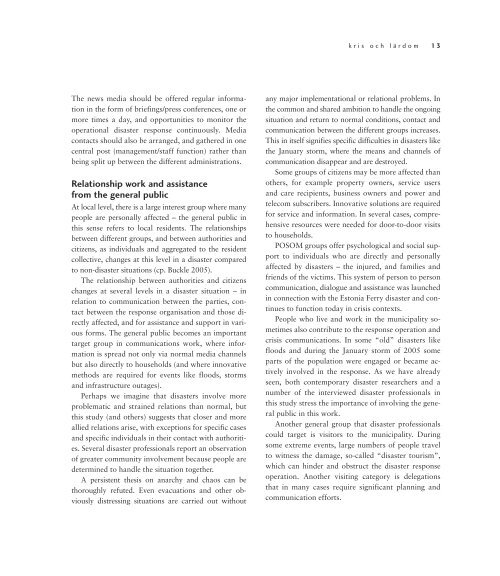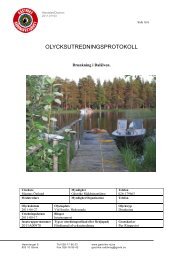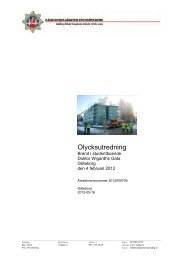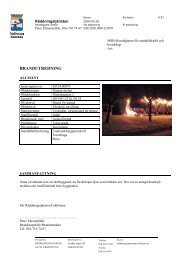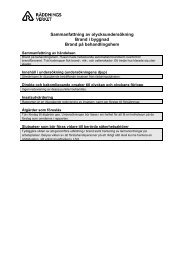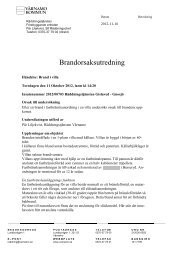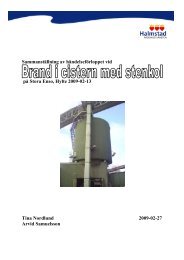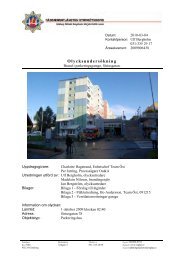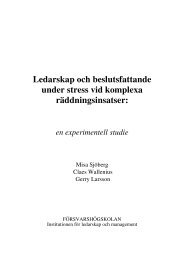Sverige
Sverige
Sverige
You also want an ePaper? Increase the reach of your titles
YUMPU automatically turns print PDFs into web optimized ePapers that Google loves.
kris och lärdom 13<br />
The news media should be offered regular information<br />
in the form of briefings/press conferences, one or<br />
more times a day, and opportunities to monitor the<br />
operational disaster response continuously. Media<br />
contacts should also be arranged, and gathered in one<br />
central post (management/staff function) rather than<br />
being split up between the different administrations.<br />
Relationship work and assistance<br />
from the general public<br />
At local level, there is a large interest group where many<br />
people are personally affected – the general public in<br />
this sense refers to local residents. The relationships<br />
between different groups, and between authorities and<br />
citizens, as individuals and aggregated to the resident<br />
collective, changes at this level in a disaster compared<br />
to non-disaster situations (cp. Buckle 2005).<br />
The relationship between authorities and citizens<br />
changes at several levels in a disaster situation – in<br />
relation to communication between the parties, contact<br />
between the response organisation and those directly<br />
affected, and for assistance and support in various<br />
forms. The general public becomes an important<br />
target group in communications work, where information<br />
is spread not only via normal media channels<br />
but also directly to households (and where innovative<br />
methods are required for events like floods, storms<br />
and infrastructure outages).<br />
Perhaps we imagine that disasters involve more<br />
problematic and strained relations than normal, but<br />
this study (and others) suggests that closer and more<br />
allied relations arise, with exceptions for specific cases<br />
and specific individuals in their contact with authorities.<br />
Several disaster professionals report an observation<br />
of greater community involvement because people are<br />
determined to handle the situation together.<br />
A persistent thesis on anarchy and chaos can be<br />
thoroughly refuted. Even evacuations and other obviously<br />
distressing situations are carried out without<br />
any major implementational or relational problems. In<br />
the common and shared ambition to handle the ongoing<br />
situation and return to normal conditions, contact and<br />
communication between the different groups increases.<br />
This in itself signifies specific difficulties in disasters like<br />
the January storm, where the means and channels of<br />
communication disappear and are destroyed.<br />
Some groups of citizens may be more affected than<br />
others, for example property owners, service users<br />
and care recipients, business owners and power and<br />
telecom subscribers. Innovative solutions are required<br />
for service and information. In several cases, comprehensive<br />
resources were needed for door-to-door visits<br />
to households.<br />
POSOM groups offer psychological and social support<br />
to individuals who are directly and personally<br />
affected by disasters – the injured, and families and<br />
friends of the victims. This system of person to person<br />
communication, dialogue and assistance was launched<br />
in connection with the Estonia Ferry disaster and continues<br />
to function today in crisis contexts.<br />
People who live and work in the municipality sometimes<br />
also contribute to the response operation and<br />
crisis communications. In some “old” disasters like<br />
floods and during the January storm of 2005 some<br />
parts of the population were engaged or became actively<br />
involved in the response. As we have already<br />
seen, both contemporary disaster researchers and a<br />
number of the interviewed disaster professionals in<br />
this study stress the importance of involving the general<br />
public in this work.<br />
Another general group that disaster professionals<br />
could target is visitors to the municipality. During<br />
some extreme events, large numbers of people travel<br />
to witness the damage, so-called “disaster tourism”,<br />
which can hinder and obstruct the disaster response<br />
operation. Another visiting category is delegations<br />
that in many cases require significant planning and<br />
communication efforts.


